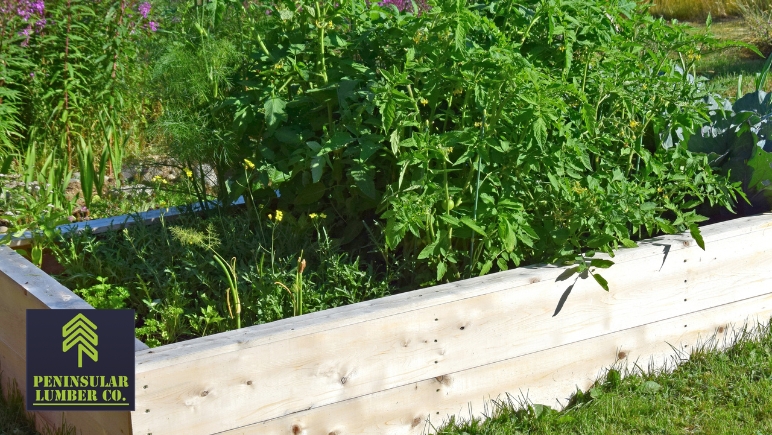Steps To Build Raised Garden Bed DIY With Lumber
If you want to build your own raised vegetable garden, look no further. Making a garden bed is a great way to add a unique and beautiful addition to your backyard. With just a few essential tools and supplies, you can easily create a gorgeous, raised garden bed that will last for years. This guide will provide you with all the steps and tips you need to build a DIY raised garden bed.
Necessary Tools
Before you start to build a raised garden bed, you must have the following building materials and tools:
- Pressure-treated lumber in the size and type of your choice.
- Wear work gloves to protect your hands from splinters and other debris while handling the lumber.
- Drill for creating holes in wood and other materials.
- A wheelbarrow to transport the lumber and other materials to and from the work site.
- Nails or screws for attaching the lumber pieces.
- Hammer for nailing or screwing.
- Pressure-treated wood from a reliable lumber yard
- Measuring tape for measuring the length, width, and depth of materials.
- Use a saw for making precise cuts in lumber.
- Level for ensuring the garden bed is even
- Shovel to dig the hole for the garden bed.
- Safety goggles for protecting your eyes from debris and dust while sawing and drilling.
After gathering all these tools and materials, here are the steps to follow.
1. Outline The Garden Layout
As you start building a raised bed, you will need to plan out the layout of your garden first to achieve home improvement. Start by measuring the area you will be using for your garden bed. This will help you determine the size of your bed and the amount of lumber you will need. Keep in mind the size of your plants and how much room you want for pathways and other features.
It’s also important to consider the amount of sunlight the area receives and how much drainage it has. Once you have determined the size of your garden bed, use string or chalk to outline the perimeter of your bed. This will help you visualize the layout and ensure everything is the correct size to enhance the custom home building.
2. Remove the Grass
To remove the grass from the garden bed, you will need to start by loosening the soil. Use a spade or a garden fork. Work the tools into the ground, turning it over and breaking it up until it is loose and easy to work with.
Then use a trowel to remove the grass and its roots from the area. Take care to remove as much of the root system as possible. This helps ensure that the plants in the garden bed have access to the necessary nutrients in the soil.
3. Measure the Boards to Build Raised Garden Bed DIY
Measure and cut the boards to the desired size for your bed and as per your garden layout. You will need a measuring tape, a saw, and lumber. Start by measuring the length and width of the bed you want to build.
Consider the boards’ thickness when measuring, as this will affect the overall size of your bed. Use the saw to cut the boards to the desired length and width. Use rot resistant wood from a legit lumber company in Tampa.
4. Mark Where Framing Angles Will Go
This is done by laying out the lumber and then marking the points where the corners of the bed will be with a pencil or marker. It is essential to be precise when marking these points, as any errors could result in the bed frame not being square. You can use a framing square to double-check that the angles are square, and the frame is accurate.
5. Drill the Lumber to Build Raised Garden Bed DIY
You can now begin to drill pilot holes at the marked locations. Make sure to drill straight into the lumber and not at an angle. Keep the drill bit lubricated to prevent it from overheating.
6. Attach Framing Angles and Form Planter Box
Use the pre-drilled holes to attach the framing angles with screws to form a box. Use screws that are appropriate for the type of framing angle and lumber you are using. Ensure to place the framing angles on the inside of the box to build the raised garden bed properly.
7. Attach Hardware Cloth to the Planter Box
Hardware cloth is made of metal mesh and is used to prevent burrowing animals from entering the planter box and disrupting the soil. Begin by cutting the hardware cloth to the size of the planter box. Make sure to leave about an inch of overhang.
Then, use galvanized nails or screws to secure the hardware cloth to the sides of the planter box tightly to prevent any gaps from forming. This will ensure that animals cannot gain access to the planter.
8. Line the Planter Box with Landscape Fabric
Landscape fabric helps to keep the soil from washing away when it rains or when you are watering the plants. It should be laid down on the bottom of the box first, and then the sides should be lined with the fabric, overlapping each edge and tucking it into the sides of the box. This will help to create a barrier that will keep the soil in the box and the weeds out.
9. Add Soil to the Raised Bed
You will need to add soil to your box. This will provide the foundation for the bed and allow your plants to thrive. Start by measuring the area of your bed to determine the volume of soil needed, and then use a tiller or garden fork to loosen and aerate the soil.
Use a balanced soil mix that is appropriate for your climate and the type of plants you are growing. Many gardeners and custom home builders opt for a combination of compost, peat moss, and topsoil. This will help provide nutrients to your plants.
Make sure the soil is level and pack it down lightly to avoid creating air pockets. Your soil is now ready for planting.
10. Plant Your Garden
The final step to building a raised garden bed DIY using lumber is to plant your garden. Decide what type of plants to grow in your garden during the growing season by considering the kind of soil and light your plants need. Once you have your plants, dig a hole for each one that is slightly larger than the root ball.
Then, take the plant out of its pot and place it in the hole. Gently fill in the soil around the plant and water it in. Make sure to regularly water your plants in your raised bed project since it is essential for their health and growth. Monitor the moisture level of the soil and adjust your watering schedule accordingly.
For all the lumber you need for your DIY projects, visit Peninsular Lumber in Tampa Bay. Our lumber store has served the Tampa Bay area for over 75 years. We look forward to helping you find the lumber solutions you need.



